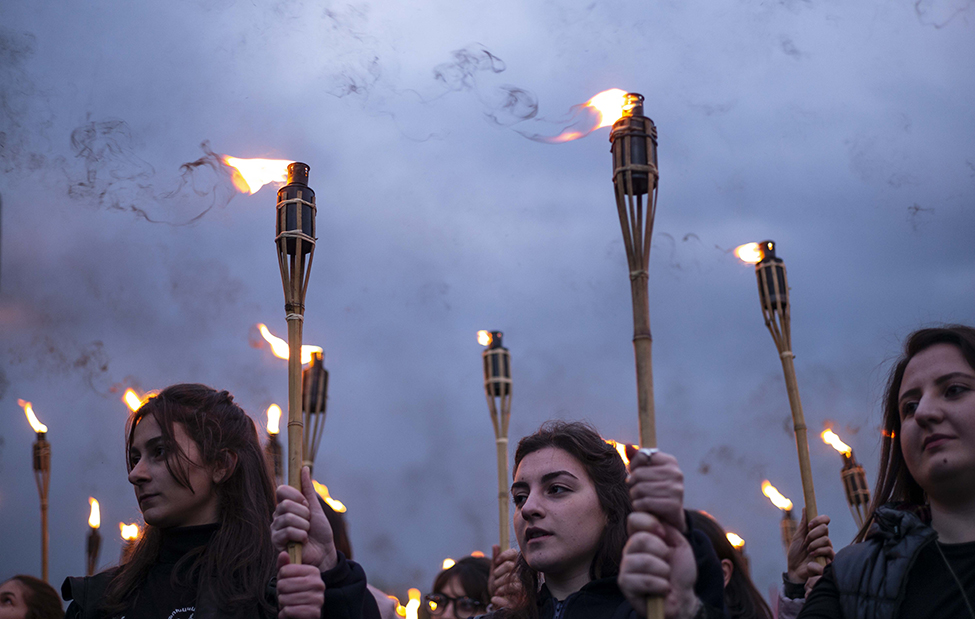Jacopo Santini – Armenia 301. Parte Prima

La Galleria SACI è lieta di presentare “Armenia 301, Parte Prima”, una selezione di immagini da un progetto in corso del professore di fotografia presso Studio Arts College International Jacopo Santini.
Comunicato stampa
Jacopo Santini
ARMENIA 301
‘301 First part. Armenia: Memory of the Genocide’
SACI Gallery
Via Sant’Antonino 11 - Florence
OPENING RECEPTION: Thursday, January 15 at 6pm
ON VIEW: January 15 - February 9, 2020
The SACI Gallery is pleased to present "Armenia 301," an exhibition of works by SACI photography instructor Jacopo Santini. Jacopo will present the first section of a documentary project whose goal is to show how the preservation of the memory of the Armenian genocide and the denial of the same event have shaped profoundly, respectively, Armenian and Turkish societies. He will continue to pursue the project in Turkey, Syria and Lebanon through 2021.
301 (A.C.) is the year when, according to the tradition and not without some bloody hesitations, Armenia received Christianity from the will of King Tidrate III as a national religion, first among all peoples.
301 is also the article of the Turkish penal code that punishes with criminal penalties any offense to Turkish identity. It goes without saying that this provision has been used, repeatedly and often, to intimidate and sanction all forms of dissent and, particularly, any mention of what every Turkish government has always denied, Metz Yegern: In Armenia it means “the great sorrow,” the first genocide of the 20th century that, between 1915 and 1918 (and even beyond), took the lives of approximately 1.500.000 Armenians living in what is currently Eastern Anatolia, according to a plan meticulously drafted and carried out by the Young Turks that could rely on the hypocritical collusion of many major powers that, so far and despite all historical evidence, haven’t recognised the genocide as such.
Oliver Wendell Holmes in 1859 referred to photography as to a “mirror with a memory”. It still can be despite all doubts related to two digital revolutions. The real dilemma is how and what to photograph one hundred years after the facts to keep from reducing this project to a maudlin and pointless exercise of archeology.
“When I started my research I could not help thinking of Walter Benjamin’s Angelus Novus (and of the inspiring Paul Klee’s painting), his eyes on the past, on the countless tragedies that, under his gaze dragged towards the future by the wind named progress, are nothing but a single heap of debris. [...]
Whoever wants to talk about the Armenian genocide today must deal with the present, with what remains, with the memory of the past in people and communities’ words and habits, in the places where those old and unforgettable events took place: Armenia, Turkey, Syria, Lebanon. [...] The purpose is to sew memories, words, and images, and to bear witness to the present as a reflection, faint but still alive, of before. It isn't an investigation, whose results are already available and indisputable, but a testimony. History can be often told by observing it reflected in the eyes of who survived, as in Angelus Novus’ pupils, not closed yet by the wind of progress." - Jacopo Santini
Jacopo Santini
ARMENIA 301
‘301 Parte prima. Armenia: la memoria del genocidio’
SACI Gallery
Via Sant’Antonino 11 - Firenze
INAUGURAZIONE Giovedì, 15 gennaio, ore 18
15 gennaio – 9 febbraio, 2020
La Galleria SACI è lieta di presentare "Armenia 301, Parte Prima", una selezione di immagini da un progetto in corso del professore di fotografia presso Studio Arts College International Jacopo Santini. Jacopo Jacopo presenterà la prima fase di un progetto, realizzato grazie al Fondo di Sviluppo istituito da SACI, il cui scopo è documentare come il ricordo e la negazione o rimozione di uno stesso evento, il genocidio Armeno, abbia plasmato profondamente le società Armena e Turca. e continuerà il progetto in Turchia, Siria e Libano anche nel 2021.
301 (dopo Cristo) è l’anno in cui, stando alla tradizione e dopo una serie di cruente indecisioni, l’Armenia accolse il Cristianesimo, per volontà del re Tidrate III, e ne fece la religione nazionale, primo - si dice - fra i popoli. 301 è anche l’articolo del codice penale turco che sanziona – con pene detentive – ogni offesa all'identità turca", disposizione usata spesso e volentieri per punire varie forme di dissenso e, ovviamente, ogni menzione di ciò che da 100 anni è in Turchia negato, Metz Yegern: il grande dolore, il primo genocidio del ‘900 che, tra il 1915 e il 1918 (con sanguinosi strascichi successivi), per piano e mano dei Giovani Turchi, costò la vita a circa 1.500.000 Armeni all’epoca residenti nei territori del fu Impero Ottomano, soprattutto nell’attuale Anatolia orientale (o Armenia occidentale). Questo genocidio ha potuto contare sull’ipocrita complicità di un buon numero di nazioni che, ad oggi non lo hanno riconosciuto come tale, nonostante il concorde avviso della comunità scientifica internazionale circa la copiosità, l’univocità e l’inconfutabilità delle prove.
“La fotografia” – disse Oliver Wendell Holmes nei suoi tempi pionieristici – “è uno specchio dotato di memoria”. Può tuttora esserlo, perfino in un’epoca in cui, complice la rivoluzione digitale, è lecito dubitarne. Il dilemma è cosa fotografare a distanza di un secolo dai fatti, quando gli ultimi, pochissimi sopravvissuti, sono fragilissimi centenari, per non ridurre il lavoro ad un esercizio stucchevole di documentazione “archeologica”.
“Ho pensato, iniziando la ricerca di una struttura per il progetto, all’Angelus Novus di Walter Benjamin (e al quadro di Klee da cui mosse il pensiero del filosofo tedesco), gli occhi fissi sul passato, sulle catastrofi che, sotto il suo sguardo trascinato verso il futuro dalla tempesta che chiamiamo progresso, sono un solo cumulo di rovine. [...] Parlare oggi del genocidio, con la fotografia, non può che avvenire misurandosi con il presente, con ciò che, tangibilmente, resta del passato nel presente, con la memoria di quel passato nelle parole e nei comportamenti degli individui o in quelli delle società, nei luoghi teatro di quegli eventi lontani, nelle cose, in tutte le terre in cui si consumò Metz Yegern, Armenia, Turchia, Siria, Libano. [...]L’idea è cucire ricordi, parole ed immagini e dar testimonianza del presente come traccia e riflesso del passato, forse debole ma esistente. Non si tratta di un atto di indagine, già compiuta e con risultati indiscutibili, ma di una testimonianza. La storia la si racconta spesso osservandola riflessa negli occhi di chi, dovunque sia nato, le è sopravvissuto, come nelle pupille dell’Angelus Novus non ancora chiuse dal vento del progresso.”- Jacopo Santini



